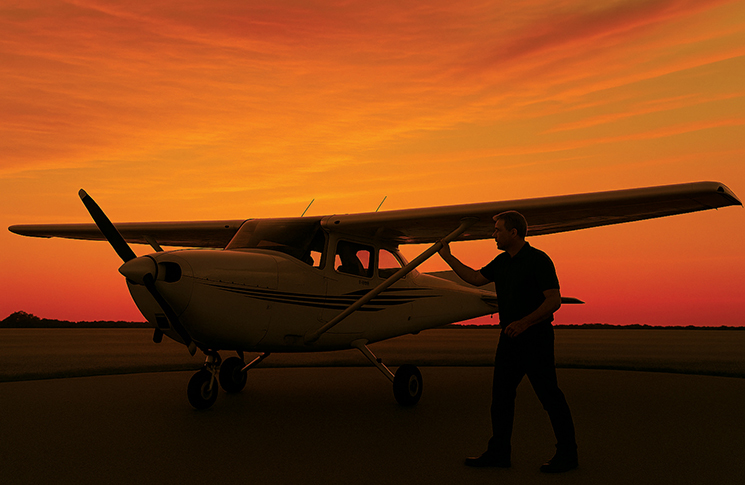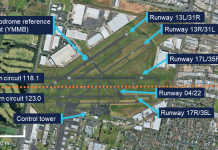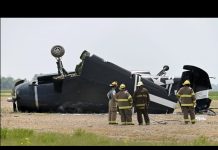‘Kick the tyres, light the fires’ is a tongue-in-cheek expression satirising the complacent attitude and confected bravado that the over-confident pilot has towards pre-flight inspections.
Another amusing saying is that the pre-flight of a DC-3 used to be, ‘Good morning, Mr Pratt, good morning, Mr Whitney’. An infinitely wiser attitude can be found in the words of World War II Qantas ‘Indian Ocean service’ Catalina pilot Ivan Peirce. When asked if he ever had mechanical problems on the 30-hour flights from Perth to Ceylon at 115 knots, he answered, ‘No, if you had a mechanical problem, you used to find it the day before.’
There is a strong connection between a thorough pre-flight inspection and good safety outcomes, and the enabling pilot attributes are discipline and airmanship.
Find the problem on the ground
Captain Peirce’s wisdom could be rephrased for pre-flight inspections. To avoid a problem in flight, find it before you take-off. The ATSB National Aviation Occurrence Database is full of examples of sometimes terrifying problems that weren’t found, simply for lack of a thorough pre-flight.
- Canberra, February 2010: a Cessna returned to the airport after take-off due to oil spraying from the engine. An inspection revealed the engine oil cap was not fitted prior to departure.
- Moorabbin, September 2010: an Aero Commander taxied and departed with the security nosewheel chock attached to the nose landing gear.
- Boigu Island, May 2011: the crew of a Britten-Norman Islander failed to secure the cargo hatch prior to take-off. Damage was noticed to the hatch after landing.
- Mangalore, September 2014: the Piper Seminole crew failed to remove the right tie-down and when the aircraft taxied, the tie-down loop was pulled from the wing.
- Tooradin, April 2015: during approach, the Morgan Cheetah landed hard and bounced twice. The pilot attempted a missed approach, however, the left wing struck the ground and the aircraft departed the runway. The pilot was seriously injured and the aircraft was destroyed.
An inspection revealed that a piece of foam used to secure the aileron had likely not been removed prior to the flight. - Port Macquarie, May 2020: during take-off, the crew heard noises emanating from the landing gear and returned to the airport. The post-flight inspection revealed the tow bar was still attached to the nose wheel.
- Mount Tom Price, December 2018: during initial climb, the DJI remotely piloted aircraft lost power and collided with terrain resulting in substantial damage. It is suspected the pre flight inspection did not identify that the battery had dislodged.
All types of aircraft, in all sorts of locations, with sometimes fatal consequences, in incidents that were potentially avoidable if a thorough pre-flight inspection had been conducted.
The ATSB National Aviation Occurrence Database is full of examples of sometimes terrifying problems that weren’t found, simply for lack of a thorough pre-flight.
No respecter of persons
It’s easy to say that inexperienced pilots make these ‘rookie errors’ but that doesn’t seem to be the case at all. In 2022, an ex-US Navy pilot with 7,800 hours on fighters (including 5,000 hours on F-14 Tomcats), with 1,200 carrier landings in his logbook, was killed in a crash attributed to his failure to remove a control lock. The aircraft concerned was not a big, complicated fighter, but a two-seat SM.1019, a turboprop derivative of the Cessna O-1 Bird Dog.
Tracy Bolt is a flight instructor and Head of Operations at Merimbula Air Services and Merit Aviation, Moruya. She can recount many examples of poor pre-flight inspections. ‘Fuel caps and pitot covers are the most common,’ she says. ‘Oil dipsticks not being replaced securely is another.’
Andrew Temby is an accomplished aerobatic display pilot. Aerobatic aircraft pre-flight inspections are arguably more critical than in general aviation, not only because of the extra stresses put on the airframe, but that loose objects can be particularly dangerous. ‘Good pre-flights can uncover hard-to-find potential problems,’ he says. ‘I know one particularly forensic pilot who has found a ruptured engine mount, a disconnected magneto earth lead, a wasp nest in a pitot tube, a loose underbelly cover and the makings of a bird’s nest in the engine bay.’
Bolt says, ‘Flying involves planning and it’s not unusual for a student to spend an hour planning an hour’s flight. This planning saves you a whole lot of worry in the air. Pre-flights are like that. They can save you a whole heap of worry.’
Complacency is one of the human factors that can be a threat to safe outcomes. Bolt imagines the following inner monologue. ‘I’ve been flying for 40 years. Daily [pre-flight inspection] was done. It’s the fifth flight of the day. I checked that last time, I don’t need to do it again.’ Or, ‘I filled the tanks the night before, we’ve got plenty of fuel.’
Bolt also points to the difference between flying by yourself and flying with someone else. It’s very easy for the delineation of roles to be unclear. She cites an example of a two-pilot crew where one thought they were loading the passengers and assumed the other had done the pre-flight. This dangerous situation is mitigated in her operation by requiring a two-pilot brief with the head of operations.
Temby says if he is the pilot in command, then he is also in command of the pre-flight. ‘It’s too easy for a question like, ‘Did you put the fuel cap back on?’ to be misinterpreted, and next thing you have fuel spraying over the wing,’ he says.

Good habits every flight
There is a distinction between the daily inspection with the maintenance release (MR) signed and the subsequent pre-flight inspection. For example, pitot and fuel vent covers and control locks may be installed between flights. Pre-flight walkarounds and inspections are, as the name implies, intended to be done before every flight.
Temby is rigorous in his inspections. Do all the doors shut cleanly? Can you see any discolouration around rivets which might reveal them working loose? Does the cowl fit properly? Is the spinner sitting low which might mean a sagging engine mount?
Tracy Bolt advises to check from afar as well as up close. ‘When you’ve finished your inspection, stand back 4 metres from the aircraft and check it from a distance, walking all the way around. It’s surprising what you might have overlooked up close.’
Most pilot operating handbooks (POH) include a pre-flight walkaround diagram and checklist; these provide a good aide-mémoire particularly when flying an unfamiliar aircraft type. Bolt has laminated checklists extracted from the POH for this reason and encourages pilots to use them. Even the experienced pilot, who doesn’t need the checklist during the inspection, can find it useful in a final double-check upon completion.
Pre-flight checks provide an opportunity to easily avoid potentially unsafe situations in the air.
Where was I? Interruptions and double-checking
Aviation tends to be very social and it’s inevitable that pre-flight inspections are going to be interrupted by a well-meaning friend or stranger complimenting your aircraft or talking about the weather. Temby always restarts the entire inspection after such interruptions, no matter how long it takes. ‘You need to be in that bubble,’ he says. ‘When you walk to your aeroplane, you should be really intently looking.’
Some potential hazards can be mitigated further by double-checking. Bolt recommends always double-checking fuel caps and oil caps. Cowlings, baggage doors and inspection panels are also good candidates for double-checking. For instructors or pilots flying with other pilots, she also recommends ‘checking the checker’.
The Maintenance release
A bad habit that some pilots fall into is to avoid recording issues in the MR; this is especially important if others will fly the aircraft.
CASA’s Civil Aviation Advisory Publication CAAP 43-01 v2.1 reminds pilots that ‘the maintenance release also provides a maintainer with a record of deferred defects and other maintenance actions that require attention during both unscheduled and scheduled maintenance.’ A fuel cap that might be hard to tighten might not require rectification before flight but can be important information for a pilot about to check over the aeroplane.
Temby looks with suspicion at MRs that have no record of defects. ‘The MR provides a history, so if there’s no history of defects and rectifications, there’s usually missing information,’ he says.
The pre-flight inspection becomes even more important if anyone has done work on your aircraft, either yourself or another pilot or your LAME (and remembering there are 25 maintenance tasks that a pilot can be authorised to do under Schedule 8).
When the aircraft comes back from maintenance, it’s a good idea to extend your pre-flight inspection beyond the POH checklist. Temby gives an example. ‘If someone else has removed and replaced a seat under Schedule 8, don’t assume they knew what they were doing. Check that you are satisfied that it has been replaced correctly.’
Post-flight inspections
While there is a lot of emphasis on pre-flight inspections, a post-flight inspection can pick up problems a lot earlier and at a more convenient time. Temby cleans the windscreen before flight. Then, after landing, he inspects the windscreen again, looking for traces of oil or grease or fluid, all of which can be indicators of an upcoming problem. A streak of brake fluid might mean a failing seal on the master cylinder. Some grease might indicate a looming problem with the propeller governor. ‘Squashed bugs are OK, provided they’re on the outside!’ he quips. ‘It’s easy to spend 5 minutes after your flight wandering around the aeroplane making sure that nothing is out of the ordinary.’
Bolt agrees and points to the usefulness of checking the fuel after landing. ‘We dip the tanks pre- and post-flight to make sure we’re using what we expect to be using, as excessive fuel consumption points to something wrong.’
Non-controlled airspace and aerodromes is one of the special topics on our Pilot safety hub. Refresh your knowledge at casa.gov.au/pilots.
Becoming better
‘Knowing the aeroplane you’re flying’ is a good starting point for being better at pre-flight inspections. The POH or the authorised flight manual for any aircraft includes pre-flight inspection procedures, but another source can be other pilots or instructors familiar with the specific aeroplane.
Bolt suggests extending the idea of the ‘sterile cockpit’ to the ‘sterile walkaround’ by taking steps to ensure you are not interrupted or having a plan if you are. On a similar note, she also recommends avoiding being rushed. ‘A little extra time on the ground can remove a lot of stress in the air.’ Asking someone more experienced for advice is always a good approach.
Temby goes a little bit further and suggests asking a LAME to help with a pre-flight, particularly when you are unfamiliar with the specific aeroplane. He also suggests washing the aeroplane yourself to become familiar with it and locate problems such as oil leaks or fuel staining.
Both strongly recommend using checklists as good practice, along with approaching the pre-flight with the right mindset. It’s not just a box that has to be ticked – pre-flight checks provide an opportunity to easily avoid potentially unsafe situations in the air.
The Qantas Indian Ocean service flew Catalinas over water for 5,600 km non-stop, from Perth to Colombo, through enemy territory, in radio silence, using a sextant for navigation. The service made 271 such impossible crossings and never lost an aircraft. The skill, discipline and airmanship of these repeated feats is almost beyond belief. Today’s pilots could never be faulted for taking on board Captain Peirce’s casual observation, that it’s easier to fix problems before you leave the ground.





